2016 Annual Report for FNE16-845
Taking no-till corn a step (or two) further
Summary
Thanks to effective outreach from Cooperative Extension coupled with proven benefits for early adopters, Maine’s dairy producers are migrating to no-till crop production methods. However, there are downsides, chief among them: (1) the need to apply herbicides to kill the cover crop before planting corn, and (2) the increased challenges of effectively seeding down when it comes time to rotate the crop. Consequently, fields go un-rotated, soil health suffers and more inputs are applied.
This project seeks to trial two approaches to addressing these related downsides to no-till. First, the project trials, compares and evaluates two alternative seeding down methods. Second, we are building from work done in North Dakota to trial co-seeding biannual hairy vetch with winter rye on corn fields and leaving the vetch (at 2 different seeding levels) to grow with the corn. This regimen, if we find that corn is not crowded out, has the potential to reduce spring herbicide treatments as well as the addition of urea to supplement nitrogen during July. An extremely favorable outcome, if widely adopted, could increase demand for non-GMO corn seed and render organic corn silage production more feasible than it is today.
We are being advised by Professor Rick Kersbergen of UMaine Cooperative Extension, as well as by our farm agronomist and feed consultant/nutritionist. During 2016, this assistance included field assessments, plant counting, plot layouts, soil sampling, data interpretation, seed selection, planting technique, troubleshooting, and — unfortunately — disaster recovery. Due primarily to the drought, our seeding down experiment failed in all respects, rendering the trial as designed impossible.
Objectives/Performance Targets
Project Management:
The project team assembled in early April to revisit objectives, timelines and roles. Existing soil samples were reviewed and determined to be adequate for baseline until September corn/vetch field samples were to be taken.
Experiment #1: Seeding Down Alternatives:
Our intent was to measure the planting densities of both clover and tall fescue on five fields, comparing the results of fall drilling (done 10/2/15) vs. snowmelt broadcasting (2/26/16). Enhance Brand Tall Fescue was planted at 20 lb/acre. Red clover was planted at 2.78#/acre. Triticale was drilled as a cover crop in the fall at the same time and rate of 122 lb/acre on all fields.
We took 2 measurements during May. Fescue and clover plants were counted within 3 random 2 square foot plots in each side of each field (total of 24 plots, 12 each of fall drilled vs. frost-seeded).
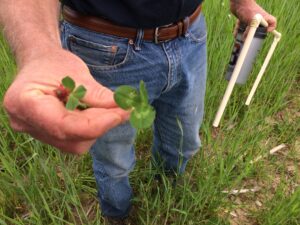 One of few clovers counted and random plot-finding tool used
One of few clovers counted and random plot-finding tool used
The first was on May 9 when the triticale was about 3” high. The observations were generally discouraging; fescue and especially clover counts were very low. We were hopeful that more plants would emerge by later in the month. It became clear that one field had been mistakenly planted on the same side both in the fall and the spring. This field was taken out of the experiment.
The second set of counts was done on May 24, when the triticale was 12–16” high and almost ready to harvest. It was clear that the February 28 frost seeding had failed, likely due to the severe up and down temperature swings during March and April since the seeding. While the fall-drilled plant counts were somewhat higher than they had been on May 9, they were still extremely disappointing. Very few clover plants had emerged. We determined that a higher seeding rate would be employed in the future. The raw counts were as follows: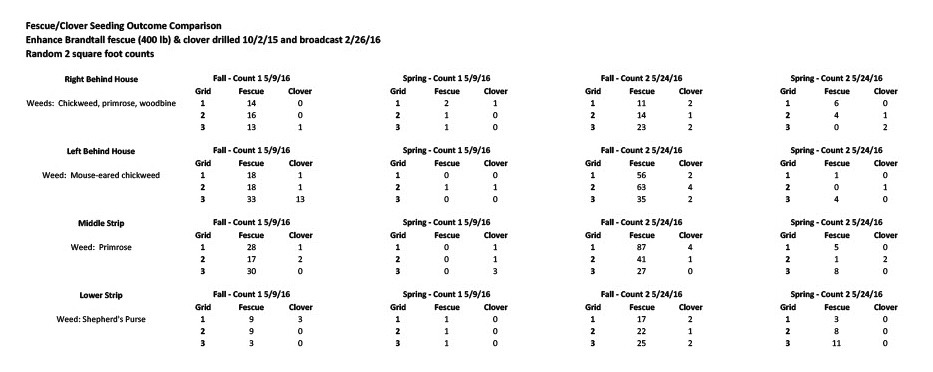
The triticale, on the other hand, had done very well. It was noted that the same planting pattern had been employed for drilling the permanent and cover crops, and that the triticale had apparently out-competed the fescue and clover in what were often about the same planting row. It was noted that it would be preferable to change planting direction as much as possible to prevent this possible hindrance to success. The impracticability of achieving this objective on many fields was also noted.
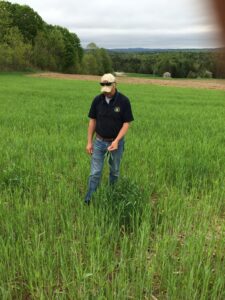 Triticale evaluated on May 24: Ready to harvest.
Triticale evaluated on May 24: Ready to harvest.
Regarding the triticale, the team witnessed a surprise finding on May 24. Across all 4 fields, the triticale was 25% taller on the side where it had been run over again with the drill seeding (see photo). The theory is that the aeration with the drill released more nitrogen to those seeds. The rye cover crop planted as part of Experiment #2 will be checked in the spring to see if the vetch over-drilling produces a similar result. It was further noted that there were plentiful worm middens, a testament to the general success of the no-till planting that had been employed on these fields for the last several years.
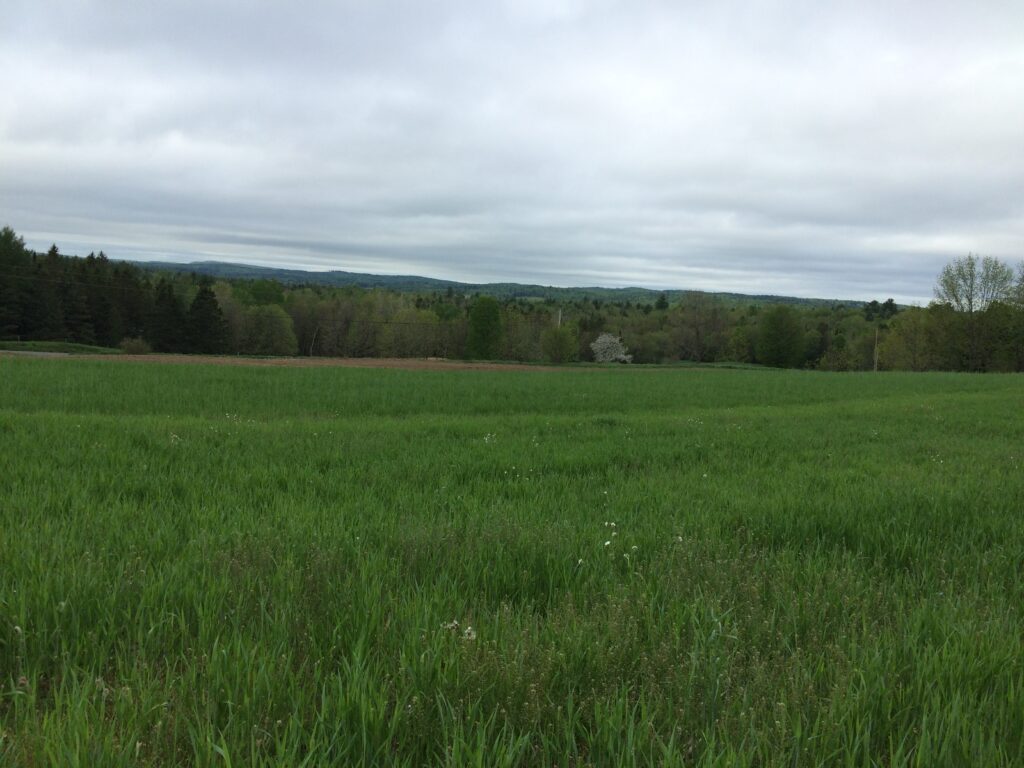 Unexpected Discovery: Triticale 25% higher where followed with drill
Unexpected Discovery: Triticale 25% higher where followed with drill
The triticale was harvested on May 26; this went well. It became clear that all 5 fields had a failed seeding down and it was agreed to reseed. It was also agreed that the farm could not afford to do a second year trial of fall drilling vs. frost broadcasting. All further seeding would be by drill (still committed to no-till). The ongoing comparative yield data that had been planned could not be completed.
Then, very unfortunately, the lack of rain resulted in a second crop failure on all 5 fields. A summer forage seeding of sorghum-sudangrass was considered but rejected. Advice was taken to cancel the remainder of Experiment #1 and focus on Experiment #2. The 5 fields were treated with glyphosate and seeded a third time on August 20, when rain that had been forecast came up short of expectations. This time a more diverse seed mixture was used to further reduce risk (Seedway 350 Haymaster Mix: 35% Premium Tall Fescue, 30% Premium Orchardgrass, 15% Red Clover, 10% Perennial Ryegrass & 10% Festulolium planted at 36#/acre, slightly higher than the recommended 30#/acre). We will not know the results of that attempt until spring. Clearly, this failure has been very expensive and a reminder of the crop rotation risk factor. While not foreseeable, 2016 was a record drought year in Maine. No one we know of had a successful perennial grass seeding down experience.
Experiment #2: Hairy Vetch Planted with Corn:
On September 20, we marked out the fields for the corn/vetch trial and took baseline soil samples. These will be analyzed this winter, when it its slightly less costly. The fields were divided into two similar halves (one upland and one lowland), and then again in thirds. Each sample field is about 1.75 acres in size. Tree flags were marked to identify the plots and a diagram was made. Winter rye was planted uniformly at 75 lb/acre across the entire area. Vetch was planted at 10 lb/acre on one pair of thirds and at 15 lb/acre on another pair. The final third of each field was left as the control.
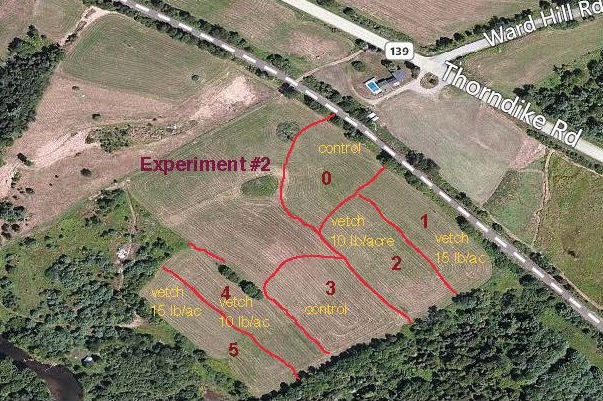 Experiment #2 Field Layout
Experiment #2 Field Layout
In May, the winter rye will be killed, manure will be applied and corn will be planted uniformly across the test fields. In late June, fields will be scouted for weed emergence and results recorded; the project team will convene to review observations, compare any difference among the test fields, and decide if any further herbicide application is necessary.
In early July, test plots will be established in these fields. Populations of both corn and vetch will be counted and compared. Corn height will be measured and compared. Soil N will be measured. A decision will be made whether to add N to any of the fields. Observations will be documented and photographed.
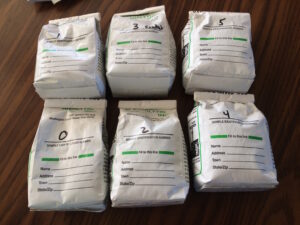 Baseline Soil Samples
Baseline Soil Samples
In early August, populations, height, stalk condition and color will be measured and photographed. Soil moisture and N will again be tested and compared, along with any visual observations of differences between the fields with each level and without vetch, including signs of stress on the corn, weed types and populations. Conditions will be noted that are worthy of follow up prior to harvest.
In early September, the test plots will again be checked, with a focus on comparing ear size and density as well as stalk height. Yields per acre will be calculated and compared. Weather conditions through the summer will be documented, and the difference in soil and crop conditions attributable to each density of vetch will be recorded. It may be apparent at this point which density of vetch is preferable, if at all. This will provide an excellent opportunity for a twilight grower walk to share results prior to corn harvest.
Following harvest, soil samples will again be taken, noting relative changes from prior samples on each field and drawing conclusions as appropriate. The fields and controls will be drilled with winter rye at approximately 75 lb/acre. The vetch is biannual so should not need to be reseeded.
The same methods will be applied during the 2018 growing season, except that greater attention will be given to observations regarding comparative weed suppression and soil health with the vetch in place longer. A decision will be made whether to treat fields with different herbicide applications as weeds present, and compare results.
Following yield comparisons and harvest, soils will again be sampled and analyzed. Quality changes in the soils will be documented as well as yields to generate a productivity score for each field. The cost of applications on each field will be calculated and a net profitability score will be generated for each field. The project team will meet to evaluate the results and discuss ramifications for farm management going forward.
Accomplishments/Milestones
- The wider variations in climate (temperature and water), while favoring no-till planting, render all seeding applications at higher risk than historical averages.
- The frost seeding method becomes especially prone to risk so will not be recommended unless a reliable weather forecast underwrites it.
- The use of a drill as a substitute aerator to release soil N or other nutrients following seeding is worth further exploration.
Collaborators:
Farm Owner
Ward Dairy Farm
200 Ward Hill Rd
Thorndike, Maine 04986
United States
Office Phone: 207-416-8787
Farm Manager
Ward Dairy Farm
200 Ward Hill Rd
Thorndike, Maine 04986
United States
Office Phone: 207-215-8787
Extension Educator
University of Maine Cooperative Extension
992 Waterville Rd.
Waldo, ME 04915
Office Phone: 207-342-6971 x1014